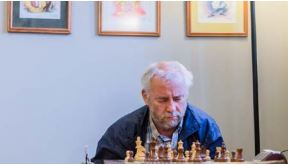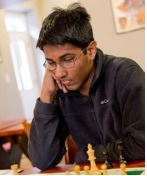 In its 97 year history, the Boylston Chess Club has always prided itself on offering tournaments for players of all levels. My personal believe has always been that there is a strong trickle-down effect when it comes to chess tournaments. If more masters and experts play, they will draw many more Class A players and Class B players that want a chance to play games against the strongest possible opposition. In 2016, the Boylston Chess Club had 354 different players, including 36 masters and 41 experts. This is a marked increase from 2015 when there were 308 different players featuring 22 masters and 31 experts. With the stronger players at the top, total tournament attendance increased 25% year over year. In its 97 year history, the Boylston Chess Club has always prided itself on offering tournaments for players of all levels. My personal believe has always been that there is a strong trickle-down effect when it comes to chess tournaments. If more masters and experts play, they will draw many more Class A players and Class B players that want a chance to play games against the strongest possible opposition. In 2016, the Boylston Chess Club had 354 different players, including 36 masters and 41 experts. This is a marked increase from 2015 when there were 308 different players featuring 22 masters and 31 experts. With the stronger players at the top, total tournament attendance increased 25% year over year.
 In the last year, in addition to the some 70 tournaments that happen regularly, the club has started offering events for the most serious players in the state. Most notably, the recently concluded Fall FIDE Festival and the New England Masters held in March have both attracted many of the top talents in the region. The New England Masters and the Fall FIDE Festival were both FIDE-rated, and they featured large prize funds for topfinishers: both things that are not available in the Northeast on a regular basis. With the cash prizes and USCF Grand Prix points up for grabs, there was naturally a fierce fight for the top spots. In the November Fall FIDE Festival, when the dust had settled, GM Alexander Ivanov had claimed clear first in the Open section, a full point ahead of IM Denys Shmelov. Zubin Baliga (pictured) won the U2200 section with 6.0/7 with key wins over David Katsman and Mark Neale. In the last year, in addition to the some 70 tournaments that happen regularly, the club has started offering events for the most serious players in the state. Most notably, the recently concluded Fall FIDE Festival and the New England Masters held in March have both attracted many of the top talents in the region. The New England Masters and the Fall FIDE Festival were both FIDE-rated, and they featured large prize funds for topfinishers: both things that are not available in the Northeast on a regular basis. With the cash prizes and USCF Grand Prix points up for grabs, there was naturally a fierce fight for the top spots. In the November Fall FIDE Festival, when the dust had settled, GM Alexander Ivanov had claimed clear first in the Open section, a full point ahead of IM Denys Shmelov. Zubin Baliga (pictured) won the U2200 section with 6.0/7 with key wins over David Katsman and Mark Neale.
Zubin Baliga (1877)
David Katsman (1649)
BCF Fall FIDE Festival (5)
11.12.2016
Ruy Lopez [C79]
1. e4 e5 2. Nf3 Nc6 3. Bb5 a6 4. Ba4 Nf6 5. OO d6 6. Re1 b5 7. Bb3 Na5
7...Na5 is a sideline that attempts to make use of the two bishops in exchange for ceding the center to White. Far more common is 7...Be7, transposing back to main lines of the Ruy Lopez
8. d3
White chooses to keep the center closed, acknowledging that Black has the bishop pair. However, 8.d4 offers White the chance to claim an edge - 8. d4 Nxb3 9. axb3 Bb7 (9... exd4 10. Nxd4 Bb7 11. Nc3 Be7 12. Nf5 O-O 13. Bg5 Re8 14. Qd2 is a clear edge for White with the dominating position of the knights.) 10. Nc3! (10. Bg5 h6 11. Bxf6 Qxf6 12. Nc3 c6 13. d5 c5 14. Qd3 Qd8 15. Nxb5 axb5 16. Qxb5+ Qd7 17. Rxa8+ Bxa8 18. Qb8+ Qd8 was a draw in Lasker-Rubinstein, played in 1923) 10... Be7 11. dxe5 dxe5 12. Qxd8+ Rxd8 13. Nxe5 b4 14. Nd5 Nxd5 15. exd5 Rxd5 16. Bf4 and White went on to win in GeorgievHector 1-0, Haifa 1989.
8... Nxb3 9. axb3 Be7 10. Nbd2 O-O 11. Nf1 Re8 12. Ng3 Bf8
Both sides have continued with normal development plans - White plans to move the knights to the kingside in order to attack the king, and Black will attempt to defend via a kingside fianchetto after g6 and Bg7.
13. h3 c5 14. Bd2 Bb7 15. Nf5
This knight almost always comes to f5 at some point, but here Black has a chance to dramatically change the nature of the game with the break d5!
15... Qc7
15... d5! 16. Ba5 Qd7 17. Qd2 dxe4 18. dxe4 g6 19. Ng3 Qxd2 20. Nxd2 With the bishop pair and the queens off the board, Black can claim at least equality, and it is much easier to play the black side of this position.
16. Bg5
White immediately threatens to open the g-file with devastating effect. Black must avoid this. The best attempt is probably Nd7 when Black's king is safe despite the lack of black pieces on the kingside.
16... Qd8
16... Nd7 17. N3h4 d5 18. Qg4 Kh8 and surprisingly, despite the preponderance of kingside forces, White has no good way to continue the attack.
17. Nh2!
Opening the diagonal for the queen to join the attack and rerouting the knight to the powerful g4 square. h6
18. Bh4 Be7 19. Nxe7+ Qxe7 20. Ng4
Black is in serious trouble now, and must play the move Qe6 to have any chance of defending.
20... Qd8
20... Qe6 21. Bxf6 h5! 22. Bg5 (22. Ne3!? Qxf6 23. Qxh5 Re6 and Black has a very interesting defense along the third rank. White has a pawn advantage and can clearly claim an edge, but Black will hope to defend by way of a welltimed d5 break and a strong rook on g6) 22... hxg4 23. Qxg4 Qxg4 24. hxg4 a5. With the queens off the board and opposite color bishops, Black has some chances to hold.
21. Bxf6 gxf6 22. Nxh6+ Kg7 23. Qh5
Qh5 is quite clearly winning on the spot, but Nf5+ would also have led to a forced mate in 4: 23. Nf5+ Kf8 24. Qh5 Kg8 25. Qg4+ Kh8 26. Qg7#
23... Qd7 24. Nf5+ Kg8 25. Qg4+
A very nice attacking game from the winner of the U2200 section!
1-0
Several other interesting games that helped determine the final standings of the tournament:
GM Alexander Ivanov (2554)
Brandon Wu (2176)
BCF Fall FIDE Festival (2)
11.11.2016
Ruy Lopez, Closed [C95]
1. e4 e5 2. Nf3 Nc6 3. Bb5 a6 4. Ba4 Nf6 5. O-O Be7 6. Re1 b5 7. Bb3 d6 8. c3 O-O 9. h3 Nb8 10. d4 Nbd7 11. Nbd2 Bb7 12. Bc2 Re8 13. Nf1 Bf8 14. Ng3 g6 15. a4 c5 16. d5 c4 17. Bg5 h6 18. Be3 Nc5 19. Qd2 h5 20. Bxc5 dxc5 21. Reb1 Qd6 22. b3 cxb3 23. Rxb3 Qd7 24. Rb2 c4 25. Qc1 Bc5 26. axb5 axb5 27. Rxa8 Bxa8 28. Qb1 Rb8 29. Ba4
29... Qa7 30. Bxb5 Bxf2+ 31. Rxf2 Qc5 32. Qa2 Qxb5 33. Nxe5 Qb1+ 34. Qxb1 Rxb1+ 35. Kh2 Kg7 36. Rf4 Rc1 37. Nxc4 g5 38. Rf3 Nxe4 39. Nxe4 Bxd5 40. Ncd6 Re1 41. Rf5 Bxe4 42. Rxf7+ Kg6 43. Re7 Rd1 44. Re6+ Kg7 45. Nxe4
1 – 0
NM Lawyer Times (2235)
IM Denys Shmelov (2512)
BCF Fall FIDE Festival (7)
11.13.2016
Ruy Lopez [C79]
1. d4 Nf6 2. Nf3 g6 3. g3 Bg7 4. Bg2 O-O 5. O-O d6 6. c4 c6 7. Nc3 Qa5 8. Bd2 Qh5 9. Qb3 e5 10. dxe5 dxe5 11. h3 Bxh3 12. Qxb7 Nbd7 13. Qxc6 Rac8 14. Qa6 Be6 15. b3 Nc5 16. Qa5 Ng4 17. Nh4 g5 18. f3 Nf6 19. Nf5 Bxf5 20. g4
20... Bxg4 21. fxg4 Nxg4 22. Rf5 Ne6 23. Nd5 Qh2+ 24. Kf1 Nf4 25. Bxf4 gxf4 26. Rd1 Qh4 27. Qe1 Qh2 28. Rd3 Ne3+ 29. Nxe3 fxe3 30. Rxe3 Qh6 31. Rh3 Qe6 32. Be4 Rfd8 33. Qf2 Rd4 34. Qf3 Rcd8 35. Bd5 Qxf5 36. Qxf5 Rf4+ 37. Qxf4 exf4 38. Rd3 Rc8 39. Kf2 Bf8 40. Kf3 Bb4 41. Kxf4 Kg7 42. Kf5 Re8 43. Rg3+ Kf8 44. e4 Bd6 45. Rf3 Kg7 46. Rd3 Re5+ 47. Kg4 h5+ 48. Kh3 Be7 49. Rf3 f6 50. Rc3 Bb4 51. Rc2 Bc5 52. Kh4 Kg6 53. b4 Bxb4 54. c5 Be1+ 55. Kh3 Ba5 56. c6 Bc7 57. Rb2 f5 58. Rg2+ Kh6 59. Re2
1/2-1/2 |